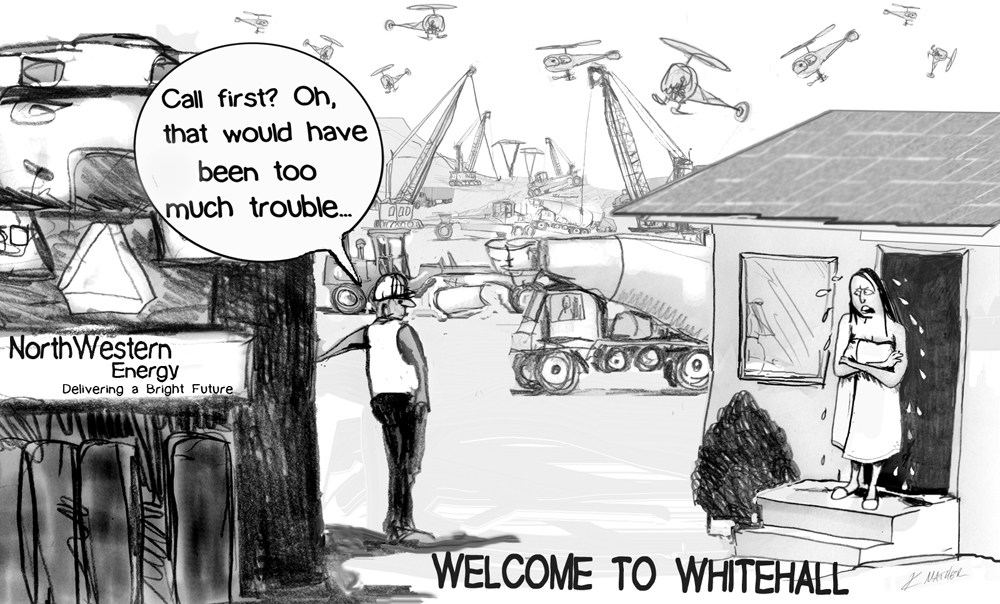The development of energy resources is typically dependent upon the availability of infrastructure such as hydrocarbon pipelines and transmission lines. Many of the issues concerning energy development and consequently infrastructure construction focus on the impact of climate change generated by a particular energy resource. The continuing controversy over the permitting of TransCanada’s Keystone XL pipeline is a flashpoint in the debate over the development of Canada’s tar sands and its impact on climate change. Likewise, many wind- power advocates champion this use of renewable energy to significantly reduce carbon dioxide emissions and catastrophic climate change.
The issues regarding energy resources and their impact on climate change are paramount to future energy policies. However, there is another significant concern tied to energy/infrastructure development, and that is the associated landowner-eminent domain problem. The movement of energy, whether it is hydrocarbons or electricity, involves infrastructure that is built in large part, on private property. When energy infrastructure is built by private corporations, these entities need to deal with private landowners so that infrastructure can be constructed on their lands. Ideally this is accomplished by corporations and landowners negotiating a fair price for the use of their lands. However, that is truly an ideal world scenario. The reality is that private corporations have lately pushed legislation through numerous state legislatures and court systems to gain the right of eminent domain for their infrastructure projects. The right of eminent domain has historically been used by governments to seize private property for public use and then to fairly compensate the owner for that ”taken” property. However, eminent domain usage for recent private infrastructure projects becomes one where private corporations can take private lands for their private gain. For example, the Montana 2011 legislature passed legislation via House Bill 198 that gives private corporations the right of eminent domain for projects such as nuclear generation and storage, hydro, certain transmission lines, certain major pipe lines, geothermal exploration, transportation links, pump stations and other facilities associated with the delivery of energy that receive permits through the Montana Major Facility Siting Act (see the Concerned Citizens Montana website for background on HB 198 and Geopostings.com for a review on Montana Senate Bill 180, the bill intended for repealing a part of HB 198 during the Montana 2013 legislative session).
In a needed first step for educating the Montana legal and legislative communities about the recent changes in eminent domain law, the State Bar of Montana CLE (Continuing Legal Education) Institute will convene a course on Montana Condemnation Rights on February 14, 2014, at Fairmont Hot Springs, Fairmont, Montana. A link to the course brochure is: MT Condemnation Rights.
The MT CLE course is well balanced in that it contains presentations from many sides of the eminent domain issue. More specific information on the CLE course presentations includes:
– CONDEMNATION 101—What every real estate practitioner should know about condemnation. An overview of condemnation law in Montana, including condemnation authority, time frames, notices, rights of possession, valuation and attorney fees and expenses. [This element of the program is intended as an overview and not a detailed consideration of the latest developments in Montana law. However, there should be a brief introduction to the US Supreme Court decision in Kelo v. City of New London (propriety of using the power of eminent domain for economic development purposes) which placed new focus on the intended scope of the power of eminent domain as well as the Montana response.] (1 hour presentation by Hertha L. Lund, Lund Law PLLC, Bozeman, Montana.)
– TAKINGS AND TRANSMISSION— This presentation will explore the range of state laws governing eminent domain authority for interstate transmission lines, particularly those designed to bring renewable energy generated in one state to customers in other states. It will focus in particular on various state approaches to granting private merchant transmission lines eminent domain authority to build transmission lines, and whether such lines are a “public use” for purposes of meeting state statutory eminent domain requirements. In addressing these issues, this presentation will discuss the Supreme Court’s Kelo v. City of New London decision, the litigation and legislative activity surrounding the Montana Alberta Tie Line (MATL) project, some historical context with regard to state constitutional and statutory grants of eminent domain to private parties in the West, and the role of “just compensation” in eminent domain disputes involving transmission lines. (1.25 hours presentation by Professor Alexandra B. Klass, Professor of Law, the University of Minnesota Law School.)
– THE EASEMENT: PROCESS, TACTICS AND SUBSTANCE- How and what to negotiate to fully protect landowners’ property rights when confronted with the possibility of transmission lines burdening their land. A negotiation/drafting checklist will emerge which prove extremely helpful for any practitioner handling future utility easements. (1 hour presentation by Dennis R. Lopach, Attorney, Helena, Mt.)
– THE MONTANA BATTLE: LITIGATION/LEGISLATION RELATING TO PRIVATE EMINENT DOMAIN FOR TRANSMISSION LINES AND OTHER CONTESTED CONDEMNATION ISSUES. A debate to highlight the opposing views by lawyers intimately involved in the process. Participants include: Hertha L. Lund (Private Landowners) Lund Law, PLLC, Bozeman, MT and John Alke (Utilities) Hughes, Kelner, Sullivan and Alke, Helena, MT. Each lawyer will be given 30 minutes to present their case in chief. (Total debate time: 1.5 hours.)
– HOT TOPIC ROUNDTABLE- A facilitated panel discussion including all speakers will address “Hot Topics” which have emerged throughout the day. (Facilitator: Brian Kahn, Attorney, Helena, MT. Total Roundtable time is 1.25 hours.)

